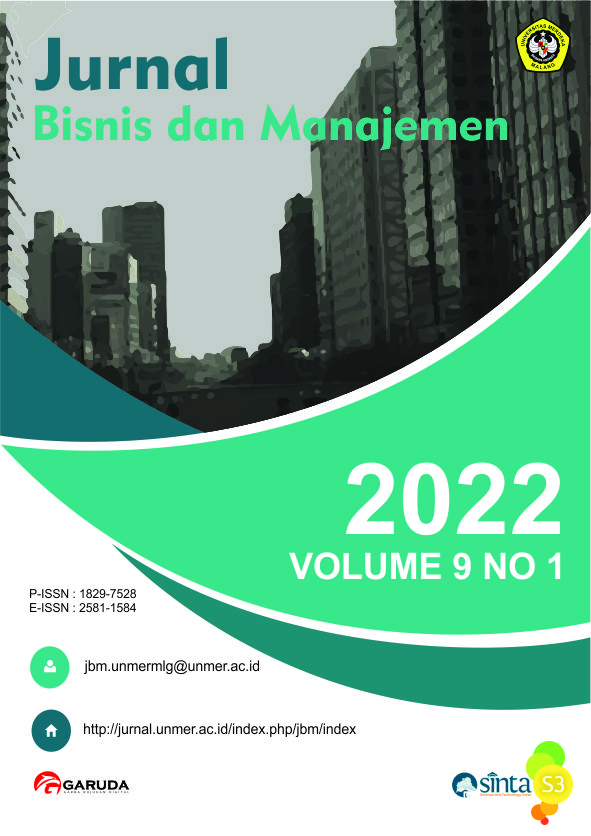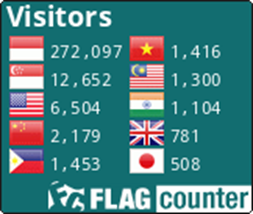Faktor-Faktor Penentu yang Mempengaruhi Niat Penggunaan Mobile Payment
DOI:
https://doi.org/10.26905/jbm.v9i1.7416Keywords:
Intention To Use Mobile Payment, Perceived Compatibility, Perceived Security, Personal Innovativeness, User MobilityAbstract
The purpose of this study is to examine the effect of Perceived Security, Perceived Compatibility, User Mobility, Personal Innovativeness, Social Norms, and Social Self Image on Intention To Use Mobile Payment on Gopay consumers in Surabaya. This study using a sample of 170 Gopay customers in Surabaya where at the time of sampling using a non probability sampling technique that is Sampling Purposive, then data was collected using an online questionnaire method and this research was conducted using the Structural Equation Model (SEM). The results showed that Perceived Security, Perceived Compatibility, User Mobility has a significant positive effect on Perceived Usefulness but for Personal Innovativeness it did not have a positive effect on Perceived Usefulness as a mediation, while for the mediating effect of Perceived Ease Of Use, the results showed that Perceived Security, Perceived Compatibility, User Mobility did not positive effect but Personal Innovativeness has a significant positive effect on Perceived Ease Of Use, for the results the mediation effect of Perceived Usefulness and Perceived Ease Of Use does not affect the relationship between Perceived Security, Perceived Compatibility, User Mobility, Personal Innovativeness on Intention To Use Mobile Payment, lastly for the influence of social norms and social self image has a significant positive effect on Intention To Use Mobile Payment.
Downloads
References
Ajzen, I. (1985), “From intentions to actions: a theory of planned behaviorâ€, in Kuhl, J. and Beckmann, J. (Eds), Action Control: From Cognition to Behavior, Springer, Heidelberg, pp. 11-39
Alshurideh, M. T., Al Kurdi, B., Masa’deh, R., & Salloum, S. A. (2021). The moderation effect of gender on accepting electronic payment technology: a study on United Arab Emirates consumers. Review of International Business and Strategy, 31(3), 375–396
Badrinarayanan, V., Becerra, E.P. and Madhavaram, S. (2014), “Influence of congruity in store-attribute dimensions and self-image on purchase intentions in online stores of multichannel retailersâ€, Journal of Retailing and Consumer Services, Vol. 21 No. 6, pp. 1013-1020
Chun, H., Lee, H. and Kim, D. (2012), “The integrated model of smartphone adoption: hedonic and utilitarian value perceptions of smartphones among Korean college studentsâ€, Cyberpsychology, Behavior, and Social Networking, Vol. 15 No. 9, pp. 473-479
Fishbein, M. and Ajzen, I. (1975), Belief, Attitude, Intention and Behavior: An Introduction to Theory and Research, Addison-Wesley, Boston, MA
Ha, Y.W., Kim, J., Libaque-Saenz, C.F., Chang, Y. and Park, M.-C. (2015), “Use and gratifications of mobile SNSs: Facebook and KakaoTalk in Koreaâ€, Telematics and Informatics, Vol. 32 No. 3, pp. 425-438
Hanafizadeh, P., Byron, W.K. and Khedmatgozar, H.R. (2014), “A systematic review of internet banking adoptionâ€, Telematics and Informatics, Vol. 31 No. 3, pp. 492-510
Hsu, C.L. and Lu, H.P. (2004), “Why do people play on-line games? An extended TAM with social influences and flow experienceâ€, Information and Management, Vol. 41 No. 7, pp. 853-868.
Kalinić, Z., Liébana-Cabanillas, F. J., Muñoz-Leiva, F., & Marinković, V. (2020). The moderating impact of gender on the acceptance of peer-to-peer mobile payment systems. International Journal of Bank Marketing, 38(1), 138–158.
Karnouskos, S., and Vilmos, A. (2004), “The European Perspective on Mobile Payments.â€,Paper presented at IEEE Symposium on Trends in Communications, Bratislava,Slovakia.
Kapoor, K., Dwivedi, Y. and Williams, M. (2015), “Examining the role of three sets of innovation attributes for determining adoption of the interbank mobile payment serviceâ€, Information Systems Frontiers, Vol. 17 No. 5, pp. 1039-1056
Kim, C., Mirusmonov, M, and Lee, I. (2010), “An empirical examination of factors influencing the intention to use mobile paymentâ€, Computers in Human Behavior, Vol. 26, No. 3pp. 310-322
Kuncoro, Mudrajad. 2003. Metode Riset untuk Bisnis & Ekonomi. Jakarta:Erlangga
Laforet, S. and Li, X. (2005), “Consumers’ attitudes towards online and mobile banking in Chinaâ€, International Journal of Bank Marketing, Vol. 23 No. 5, pp. 362-380.
Leong, C. M., Tan, K. L., Puah, C. H., & Chong, S. M. (2020). Predicting mobile network operators users m-payment intention. European Business Review, 33(1).
Lin, K. and Lu, H. (2015), “Predicting mobile social network acceptance based on mobile value and social influenceâ€, Internet Research, Vol. 25 No. 1, pp. 107-130.
Lin, K. Y., Wang, Y. T., & Huang, T. K. (2019). Exploring the antecedents of mobile payment service usage: Perspectives based on cost–benefit theory, perceived value, and social influences. Online Information Review, 44(1), 299–318.
Lu, Y., Yang, S., Chau, P.Y.K. and Cao, Y. (2011), “Dynamics between the trust transfer process and intention to use mobile payment services: a cross-environment perspectiveâ€, Information & Management, Vol. 48 No. 8, pp. 393-403
Lwin, M., Williams, J. and Wirtz, J. (2007), “Consumer online privacy concerns and responses: a powerresponsibility equilibrium perspectiveâ€, Journal of the Academy of Marketing Science, Vol. 35 No. 4
Pal, D., Vanijja, V., & Papasratorn, B. (2015). An Empirical Analysis towards the Adoption of NFC Mobile Payment System by the End User. Procedia Computer Science, 69, 13–25.
Perkins, H. W., & Berkowitz, A. D. (1986). Perceiving the community norms of alcohol use among students: Some research implications for campus alcohol education programming. International Journal of the Addictions, 21(9-10), 961–976
Ozturk, A.B., Bilgihan, A., Nusair, K. and Okumus, F. (2016), “What keeps the mobile hotel booking users loyal? Investigating the roles of self-efficacy, compatibility, perceived ease of use, and perceived convenienceâ€, International Journal of Information Management, Vol. 36 No. 6, pp. 1350-1359
Sekaran, uma dan Roger Bougie. (2010). Edisi 5, Research Method For Business: A Skill Building Approach. John Wiley @ Sons, New York
Umar, Husein. (2002). Metodologi Penelitian.untuk Skripsi dan Tesis Bisnis.Jakarta: PT. Raja Grafindo Persada
Upadhyay, P., & Jahanyan, S. (2016). Analyzing user perspective on the factors affecting use intention of mobile based transfer payment. Internet Research, 26(1), 38–56. https://doi.org/10.1108/IntR-05-2014-0143
Yang, S., Lu, Y., Gupta, S., Cao, Y. and Zhang, R. (2012), “Mobile payment services adoption across time: an empirical study of the effects of behavioral beliefs, social influences, and personal traitsâ€,Computers in Human Behavior, Vol. 28 No. 1, pp. 129-142.
Zikmund., Carr, B. dan Griffin, 2009,’Business Researc Methods’,Orlando: The Dryden Pres0073
Zikmund, William G, dan Babin, Barry J. (2012). Essential of Marketing Research - 5/E. China, Asia: South-Western Cengage Learning
Downloads
Published
How to Cite
Issue
Section
License
Authors who publish with this journal agree to the following terms:
(1) Copyright of the published articles will be transferred to the journal as the publisher of the manuscripts. Therefore, the author confirms that the copyright has been managed by the journal.
(2) Publisher of Jurnal Bisnis dan Manajemen is University of Merdeka Malang.
(3) The copyright follows Creative Commons Attribution–ShareAlike License (CC BY SA): This license allows to Share — copy and redistribute the material in any medium or format, Adapt — remix, transform, and build upon the material, for any purpose, even commercially.














